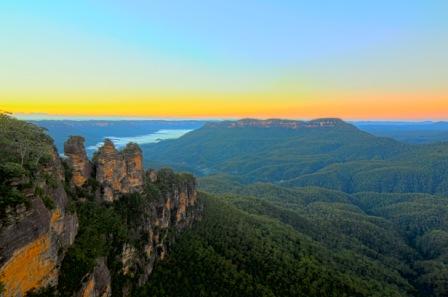The Blue Mountains

The Blue Mountains are situated about 50 kms (31 miles) and 45 minutes to the west of Sydney, the capital city of New South Wales. The Blue Mountains are part of the extensive Great Dividing Range that runs for many thousands of kilometres on the eastern seaboard from northern Queensland to Victoria.
The Blue Mountains is a very popular holiday destination and tourists are attracted to the many geological, environmental and man made attractions that abound throughout the Blue Mountains.
I have been very fortunate to have holidayed several times in the Blue Mountains – my first experience being in 1976 on my honeymoon. Back in the early 1900’s the Blue Mountains were popular with Sydneysiders who would head up the mountain during the hot summers to escape the humidity of Sydney in Summer. Many residents had holiday homes on the mountain and because of its natural beauty, it became a very popular sight for visitors to the area.
The Blue Mountains are so called because of the incredible heavily wooded national park that is home to many hundreds and thousands of oil bearing Eucalyptus trees. The unique environment is heavy with finely diffused droplets of oil, which together with the usual atmospheric dust particles and water vapour, spread short-wave length rays of light which are in the main blue in colour – hence the blue haze that inspired the name of the Blue Mountains.
In 2000 the Blue Mountains was inscribed on the World Heritage list and was also included in the National Heritage List in 2007.
There are many tourist attractions in an around the Blue Mountains including abseiling, rocksports, cycling, tours, horse riding, guided walks, eco-tourism, fishing, open gardens, arts and crafts galleries and antiques, day spas, entertainment, festivals and events and of course fabulous restaurants and cafes.
The unique natural geological environment of the Blue Mountains consists of sandstone bedrock and there are a number of rock formations that are synonymous with the area. One of these formations is called the Three Sisters and is situated on the northern escarpment of the Jamieson Valley.
Three large piles of rock sit out from the escarpment in an incredible formation. Their names are are Meehni (922 m), Wimlah (918 m), and Gunnedoo (906 m). These names are associated with an aboriginal legend that has been handed down through generations, but there is some doubt about its authenticity as a true aboriginal legend.
The Blue Mountains is a very popular holiday destination and tourists are attracted to the many geological, environmental and man made attractions that abound throughout the Blue Mountains.
I have been very fortunate to have holidayed several times in the Blue Mountains – my first experience being in 1976 on my honeymoon. Back in the early 1900’s the Blue Mountains were popular with Sydneysiders who would head up the mountain during the hot summers to escape the humidity of Sydney in Summer. Many residents had holiday homes on the mountain and because of its natural beauty, it became a very popular sight for visitors to the area.
The Blue Mountains are so called because of the incredible heavily wooded national park that is home to many hundreds and thousands of oil bearing Eucalyptus trees. The unique environment is heavy with finely diffused droplets of oil, which together with the usual atmospheric dust particles and water vapour, spread short-wave length rays of light which are in the main blue in colour – hence the blue haze that inspired the name of the Blue Mountains.
In 2000 the Blue Mountains was inscribed on the World Heritage list and was also included in the National Heritage List in 2007.
There are many tourist attractions in an around the Blue Mountains including abseiling, rocksports, cycling, tours, horse riding, guided walks, eco-tourism, fishing, open gardens, arts and crafts galleries and antiques, day spas, entertainment, festivals and events and of course fabulous restaurants and cafes.
The unique natural geological environment of the Blue Mountains consists of sandstone bedrock and there are a number of rock formations that are synonymous with the area. One of these formations is called the Three Sisters and is situated on the northern escarpment of the Jamieson Valley.
Three large piles of rock sit out from the escarpment in an incredible formation. Their names are are Meehni (922 m), Wimlah (918 m), and Gunnedoo (906 m). These names are associated with an aboriginal legend that has been handed down through generations, but there is some doubt about its authenticity as a true aboriginal legend.

Related Articles
Editor's Picks Articles
Top Ten Articles
Previous Features
Site Map
Content copyright © 2023 by Judie Bellingham. All rights reserved.
This content was written by Judie Bellingham. If you wish to use this content in any manner, you need written permission. Contact Judie Bellingham for details.






